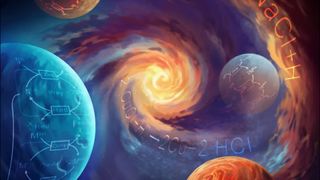Alien life may evolve from radically different elements than human life did
Radioactive metals and even certain gases may be capable of the kinds of reactions needed to spur life, new research suggests.

Self-sustaining chemical reactions that could support biology radically different from life as we know it might exist on many different planets using a variety of elements beyond the carbon upon which Earth's life is based, a new study finds.
On Earth, life is based on organic compounds. These molecules are composed of carbon and often include other elements such as hydrogen, oxygen, nitrogen, phosphorus and sulfur.
However, scientists have long wondered if alien life might evolve based on significantly different chemistry. For example, researchers have long speculated that silicon might also serve as a backbone for biology.
"It's important to explore these possibilities so that we have an idea of what all forms of life can look like, not just Earth life," study senior author Betül Kaçar, an astrobiologist, bacteriologist and evolutionary biologist at the University of Wisconsin-Madison, told Live Science's sister site Space.com.
Related: How to tell if extraterrestrial visitors are friend or foe
A kind of chemical interaction that is key to life on Earth is known as autocatalysis. Autocatalytic reactions are self-sustaining — they can produce molecules that encourage the same reaction to happen again. Envision a growing population of rabbits. Pairs of rabbits come together, produce litters of new rabbits, and then the new rabbits grow up to pair off and make even more rabbits. It doesn't take many rabbits to soon have a lot more rabbits.
"One of the major reasons that origin-of-life researchers care about autocatalysis is because reproduction — a key feature of life — is an example of autocatalysis," Kaçar said. "Life catalyzes the formation of more life. One cell produces two cells, which can become four and so on. As the number of cells multiply, the number and diversity of possible interactions multiplies accordingly."
In the new study, researchers searched for autocatalysis beyond organic compounds. They reasoned that autocatalysis could help drive abiogenesis — the origin of life from lifelessness.
The scientists focused on what are called comproportionation cycles, which can generate multiple copies of a molecule. These products can be used as starting materials to help these cycles happen again, resulting in autocatalysis.
"Comproportionation is arguably unique because it is a single reaction that produces multiples of an output — it looks a lot like reproduction," study lead author Zhen Peng, an evolutionary biologist at the University of Wisconsin-Madison, told Space.com.
To find these reactions, the scientists analyzed more than two centuries of digitized scientific documents written in many different languages. "With effective language search and translation tools, we were able to design and conduct this first-of-its-kind assessment of the pervasiveness of autocatalytic cycles," study co-author Zach Adam, a geologist at the University of Wisconsin-Madison, told Space.com.
Ultimately, the researchers discovered 270 different cycles of autocatalytic reactions. "Autocatalysis may not be that rare, but instead it might be a general feature of many different environments, even those that are really different from Earth," Kaçar said.
Related: NASA may have unknowingly found and killed alien life on Mars 50 years ago, scientist claims
Most of the 270 cycles did not employ organic compounds. Some centered around elements that are absent or exceedingly rare in life on Earth, such as mercury, or the radioactive metal thorium. A number of cycles likely only happen under extremely high or low temperatures or pressures.
The researchers even discovered four autocatalytic cycles involving noble gases, which only rarely if ever chemically react with other elements. If even a relatively inert gas such as xenon could take part in autocatalysis, "there is good reason to guess that autocatalysis occurs more easily in other elements," Peng said.
Only eight of these cycles were relatively complex ones made up of four or more reactions. Most of the 270 cycles were simple, each consisting of just two reactions.
"It was thought that these sorts of reactions are very rare," Kaçar said in a statement. "We are showing that it's actually far from rare. You just need to look in the right place."
The researchers noted that it's possible to combine multiple cycles together, even when they are very different from each other. This could lead to self-sustaining chemical reactions that generate a diverse range of molecules to produce a great deal of complexity.
"With so many basic recipes for autocatalysis on hand to draw from, a focus of research can now shift to understanding how autocatalysis, through comproportionation, may have more pronounced effects in shaping the chemistry of a planet," Kaçar said.
The scientists hope that future research can experimentally test this new cookbook they have created.
"The cycles presented here are an array of basic recipes that can be mixed and matched in ways that haven't been tried before on our planet," Peng said. "They might lead to the discovery of completely new examples of complex chemistry that work in conditions where carbon- or even silicon-based cycles are too either combusted or frozen out."
It remains uncertain how plausible these cycles are, the researchers cautioned. "It is not guaranteed that all the examples we collated can be run in a lab or be found on other astronomical objects," Peng said.
In addition to the implications this work might have for the search for life in the universe and understanding the origins of life, this research may have practical applications, such as "optimizing chemical synthesis and making efficient use of resources and energy," Adam said. "Another is for using chemical compounds for interesting tasks such as chemical computation."
The scientists detailed their findings Sept. 18 in the Journal of the American Chemical Society.
Originally posted on Space.com.
Sign up for the Live Science daily newsletter now
Get the world’s most fascinating discoveries delivered straight to your inbox.

Most Popular

By Ben Turner

By Ben Turner

By Sascha Pare
